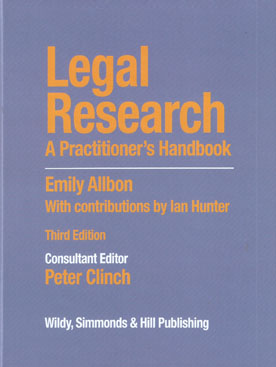Book review: Legal Research – A Practitioners Handbook, by Emily Allbon (with Ian Hunter)
Pupil barrister and former law reporter Sarah Parker welcomes to her bookshelf the latest edition of a comprehensive and detailed handbook on legal research.

Developments in technology and the increase in legal resources, both online and in print, have affected the quantity and nature of the legal research that practitioners must undertake. Free resources such as BAILII and Legislation.gov.uk put the law almost instantly into the hands of anyone with a smartphone. However, as the volume of resources and their coverage increases, finding, analysing and synthesising the law in a systematic and disciplined way has never been more important.
In this third edition of Legal Research: A Practitioner’s Handbook, senior lecturer in law at the City Law School (City, University of London) and experienced former law librarian Emily Allbon updates Peter Clinch’s handbook on legal research to take into account the availability of resources in this expanding landscape and the developments in terminology that we have seen in recent years. The book is packed full of diagrams, lists and sources of further information covering everything from preparing to conduct your research to presenting your work and choosing the commercial providers of legal resources. I was delighted to be given a copy of the handbook to road test for the ICLR blog as I left law reporting and started a pupillage in October 2019.
The handbook opens with a short section on preparing for research. While this is something a more experienced practitioner might skip over, it will be of use to those embarking on a legal career, or for those who do not routinely undertake legal research. Tips on analysing your problem, deriving keywords and choosing your sources will all help those new to research in practice (or who are a little rusty) to get things started. I certainly said a silent thank you for the section on note-taking in the first few weeks of pupillage as I retraced my steps down a research trail. The take home message for this section is that there is no “one stop shop” for finding the law. One should cast one’s net widely, triangulate sources, and ask whether a statement of the law is authoritative, accurate and as up to date as possible.
The main body of the handbook is in Part B on selecting and using sources effectively. Chapters are divided by category covering different types of legal sources: encyclopedias, legislation, case law, commentary, pre-legislative proposals, business information and more. It covers everything from when it might be appropriate to use a source, to how to use it in its paper and electronic forms and how to cite it. Chapters are further sub-divided by jurisdiction: England and Wales, Scotland, Northern Ireland, the European Union and International sources. While this is not a resource that experienced practitioners would reach for daily, it will come into its own when the researcher is outside their comfort zone. That might be, for example, where one does not routinely undertake Pepper v Hart [1993] AC 593 research (see pp 150-155) or, for those of us more comfortable with online resources, if a print reference work such as Halsbury’s Statutes needs to be consulted (see pp 49-55). Similarly, if research outside one’s usual jurisdiction or subject area is necessary then that is the time to pick up this book.
Once the research is done, Part C contains a single chapter on writing to impress. This is not a “how-to” guide on writing skills, rather it focusses on the sources to which a researcher might turn in ensuring consistency, readability and a standard style. It opens with recommendations for guides on writing skills, but unfortunately, those identified as directed at practitioners are difficult to obtain. The guides intended for the trainee, pupil or student are more readily accessible and greater in number. Most of the chapter is devoted to style manuals and style guides. The list of resources it provides for finding standard style guides, as well as resources for those developing their own in-house style guides, highlights a space for a more generally accessible law style manual in the UK, of which there are currently none (p 268). Law firms and publishers each compile their own (unpublished) in-house style manuals and so, speaking with a Law reporter’s hat on, preparing a legal document where research is drawn from various resources – the official law reports, online approved transcripts though Bailii, practitioner works and textbooks – runs the risk of a patchwork of styles if one does not exercise caution. While there are generally accepted standards emerging in legal citations, these are by no means universal and a more generally available style manual could be of wider value.
In the final section of the body of the volume (Part D) there is an overview of the legal information marketplace and some of the advantages and disadvantages of the different methods of buying commercially available legal information. There are also tips to employ when negotiating with commercial suppliers.
Over 150 pages of appendices further enhance the handbook. There are lists of abbreviations of legislation, textual devices and publications (though, as a former ICLR reporter, I would have added Bus LR for the Business Law Reports and PTSR for the Public and Third Sector Law Reports of course). The online Cardiff Index to Legal Abbreviations was originally conceived and compiled by the author of the first two editions of this work and the relationship to that work is clear. There is also an appendix of technical terms covering United Kingdom usage and other associated jurisdictions. Appendix 3 brings together in one place the court directions relating to legal research organised by court. This is another section which it is worth consulting before getting started in research.
The appendix on getting more from databases includes a table containing the main search connectors and truncators for Lawtel UK, Lexis®Library, Practical Law and Westlaw UK (I should add when using ICLR Online these can be found here). There is also an appendix containing a popular names index to UK cases and EU legislation and cases. I am sure everyone has their own examples that they could add, but this section could provide a valuable starting point when trying to orientate oneself within an unfamiliar area of law.
This book is not intended for a student audience. It is aimed squarely at practitioners; but for someone taking their first steps into pupillage it certainly has a welcome place on my bookcase. After the first few weeks I did not find myself reaching for the handbook regularly. There is a lot which is available online which can be quicker to access while in front of the computer. For example, I would be more likely to consult the Cardiff Index to Legal Abbreviations than check the appendices. However, to be able to make such searches confidently, one needs to know what to look for in the first place and that is where this handbook can come in handy. When the first or the most obvious option is not enough, or where you are using resources which you do not usually access, it can open new avenues to investigate. It also has the virtue of collecting into one place information which is otherwise scattered.
I would certainly recommend that any law library, firm or chambers would benefit from having this on their shelves. Those beginning their path into legal research in a practical context would benefit from spending some time with this volume. More experienced practitioners may find it helpful when they have drawn a blank or if they want to see if there are any other avenues worth exploring. As time goes on the information may date (the book is up to date as of February 2019), especially in relation to the online resources such as blogs and websites, but I have no doubt I will make my own notes and reminders in my copy as I use it. Then perhaps it will be time to look for the 4th edition.

Legal Research: A Practitioner’s Handbook 3rd ed, by Emily Allbon (with contribution by Ian Hunter) (Wildy, Simmonds & Hill Publishing, £49.00)
Sarah Parker is a pupil barrister at 3 Verulam Buildings and immediately prior to that was a law reporter in the Chancery Division Team at the ICLR.